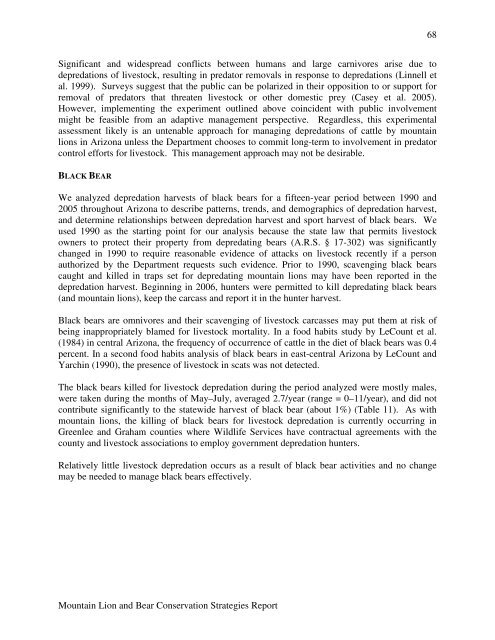Mountain Lion and Bear Conservation Strategies Report, AGFD, Jan ...
Mountain Lion and Bear Conservation Strategies Report, AGFD, Jan ...
Mountain Lion and Bear Conservation Strategies Report, AGFD, Jan ...
Create successful ePaper yourself
Turn your PDF publications into a flip-book with our unique Google optimized e-Paper software.
Significant <strong>and</strong> widespread conflicts between humans <strong>and</strong> large carnivores arise due to<br />
depredations of livestock, resulting in predator removals in response to depredations (Linnell et<br />
al. 1999). Surveys suggest that the public can be polarized in their opposition to or support for<br />
removal of predators that threaten livestock or other domestic prey (Casey et al. 2005).<br />
However, implementing the experiment outlined above coincident with public involvement<br />
might be feasible from an adaptive management perspective. Regardless, this experimental<br />
assessment likely is an untenable approach for managing depredations of cattle by mountain<br />
lions in Arizona unless the Department chooses to commit long-term to involvement in predator<br />
control efforts for livestock. This management approach may not be desirable.<br />
BLACK BEAR<br />
We analyzed depredation harvests of black bears for a fifteen-year period between 1990 <strong>and</strong><br />
2005 throughout Arizona to describe patterns, trends, <strong>and</strong> demographics of depredation harvest,<br />
<strong>and</strong> determine relationships between depredation harvest <strong>and</strong> sport harvest of black bears. We<br />
used 1990 as the starting point for our analysis because the state law that permits livestock<br />
owners to protect their property from depredating bears (A.R.S. § 17-302) was significantly<br />
changed in 1990 to require reasonable evidence of attacks on livestock recently if a person<br />
authorized by the Department requests such evidence. Prior to 1990, scavenging black bears<br />
caught <strong>and</strong> killed in traps set for depredating mountain lions may have been reported in the<br />
depredation harvest. Beginning in 2006, hunters were permitted to kill depredating black bears<br />
(<strong>and</strong> mountain lions), keep the carcass <strong>and</strong> report it in the hunter harvest.<br />
Black bears are omnivores <strong>and</strong> their scavenging of livestock carcasses may put them at risk of<br />
being inappropriately blamed for livestock mortality. In a food habits study by LeCount et al.<br />
(1984) in central Arizona, the frequency of occurrence of cattle in the diet of black bears was 0.4<br />
percent. In a second food habits analysis of black bears in east-central Arizona by LeCount <strong>and</strong><br />
Yarchin (1990), the presence of livestock in scats was not detected.<br />
The black bears killed for livestock depredation during the period analyzed were mostly males,<br />
were taken during the months of May–July, averaged 2.7/year (range = 0–11/year), <strong>and</strong> did not<br />
contribute significantly to the statewide harvest of black bear (about 1%) (Table 11). As with<br />
mountain lions, the killing of black bears for livestock depredation is currently occurring in<br />
Greenlee <strong>and</strong> Graham counties where Wildlife Services have contractual agreements with the<br />
county <strong>and</strong> livestock associations to employ government depredation hunters.<br />
Relatively little livestock depredation occurs as a result of black bear activities <strong>and</strong> no change<br />
may be needed to manage black bears effectively.<br />
<strong>Mountain</strong> <strong>Lion</strong> <strong>and</strong> <strong>Bear</strong> <strong>Conservation</strong> <strong>Strategies</strong> <strong>Report</strong><br />
68
















